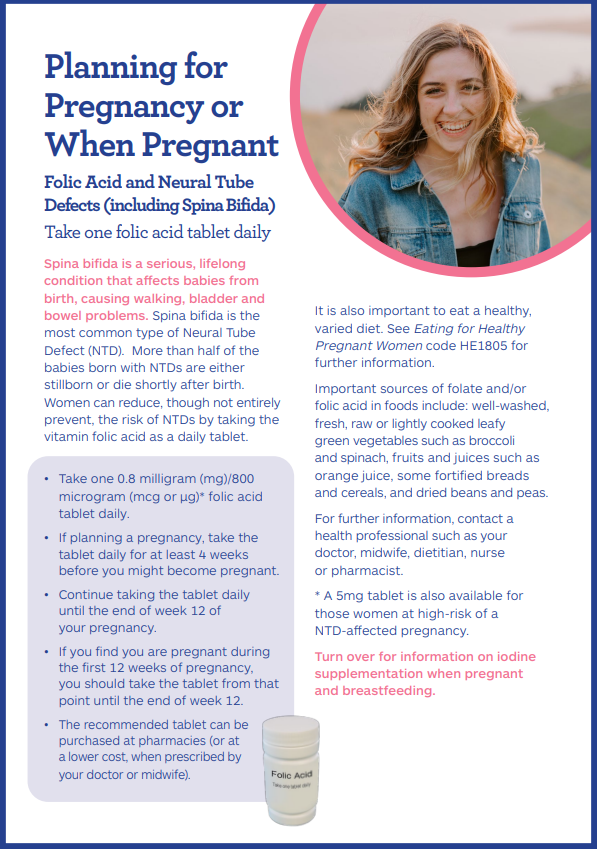Folic acid
Sounds like 'FOE-lik AS-id'
Key points about folic acid
- Folic acid is a vitamin B supplement used to prevent neural tube defects in pregnancy and to prevent side effects of some medicines.
- Most people get enough folate naturally from a healthy, balanced diet. However for some people, folate from the diet is not enough and folic acid tablets are needed.
- Find out how to take it safely and possible side effects.

Folic acid is the man-made (synthetic) form of folate, a B vitamin that is important for the formation of red blood cells and producing and maintaining new cells in your body. Most people get enough folate naturally from a healthy, balanced diet. However for some people, folate from the diet is not enough and folic acid tablets are needed.
- In pregnancy: Folic acid is used by pregnant women or women who are planning a pregnancy, to decrease the chance of spina bifida and other neural tube defects in the baby. It is best to start taking folic acid before conception and continue until week 12 of pregnancy. If the pregnancy is unplanned, start taking folic acid as soon as you know you are pregnant. Read more about folic acid/folate in pregnancy.
- For anaemia: Folic acid is used to treat or prevent some types of anaemia caused by folate deficiency by increasing the production of red blood cells. Check with your doctor first before taking folic acid to make sure it is right for you.
- To prevent side effects: For people who are taking methotrexate, folic acid is used to reduce some side effects caused by reduced folate, such as mouth ulcers.
In New Zealand, there are two funded strengths of folic acid tablets:
- 800 microgram
- 5 milligram.
Some dietary supplements and multivitamins have small amounts of folic acid, but it may not be enough for you. Talk to your doctor or pharmacist about which supplement is best for you. The following is a guide.
- Pregnancy: For the prevention of neural tube defects, the usual dose is 800 micrograms once a day.
Higher risk pregnancies: Some women who are at higher risk of having a baby with neural tube defects will need a higher dose of 5 milligrams once daily. Read more about folic acid in pregnancy. - Anaemia: The usual dose is 5 milligrams once daily.
- People taking methotrexate: The usual dose of folic acid is 5 milligrams once a week, on a different day of the week to the methotrexate. (Some people remember by taking the methotrexate on a Monday and folic acid on a Friday.)
Always take your folic acid exactly as your doctor or pharmacist has told you. The label on your medicine will tell you how much folic acid to take, how often to take it and any special instructions.
- If you are taking folic acid every day, take it at the same time each day, either in the morning OR in the evening.
- Take your folic acid tablets with a glass of water.
- You can take folic acid with or without food.
- If you forget to take your dose, take it as soon as you remember.
Side effects caused by folic acid are rare. Often side effects improve as your body gets used to the new medicine.
| Side effects | What should I do? |
|---|---|
|
|
|
|
| Read more about medicines and side effects and reporting a reaction you think might be a side effect. | |
The following links have more information on folic acid.
New Zealand Formulary Patient Information: Folic acid(external link)
Folic acid and spina bifida/iodine and iodine deficiency(external link) HealthEd, NZ, 2021
References
- Folic acid(external link) New Zealand Formulary
Brochures

HealthEd, NZ, 2021

Medicines and side effects
Healthify He Puna Waiora, NZ, 2024

Health Quality and Safety Commission, NZ, 2019
EnglishTe reo Māori
Credits: Sandra Ponen, Pharmacist, Healthify He Puna Waiora. Healthify is brought to you by Health Navigator Charitable Trust.
Reviewed by: Angela Lambie, Pharmacist, Auckland
Last reviewed:
Page last updated:





